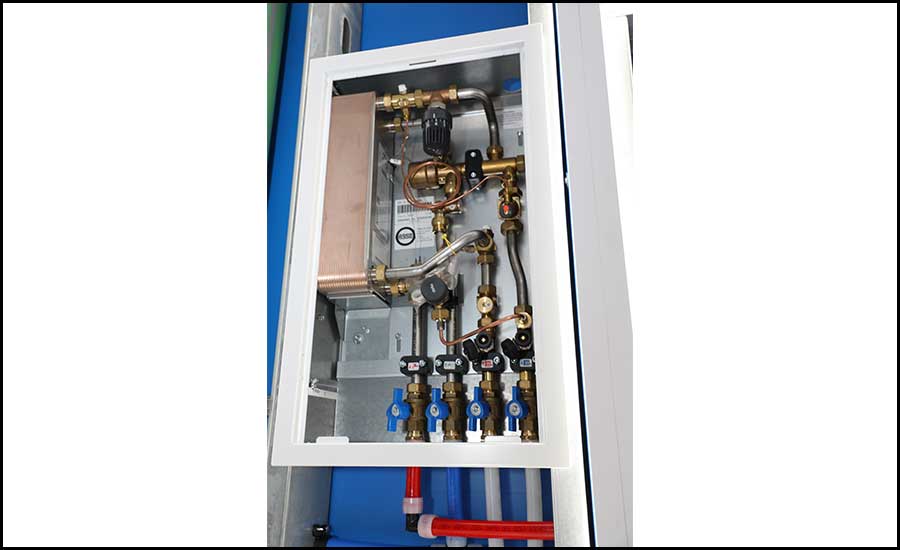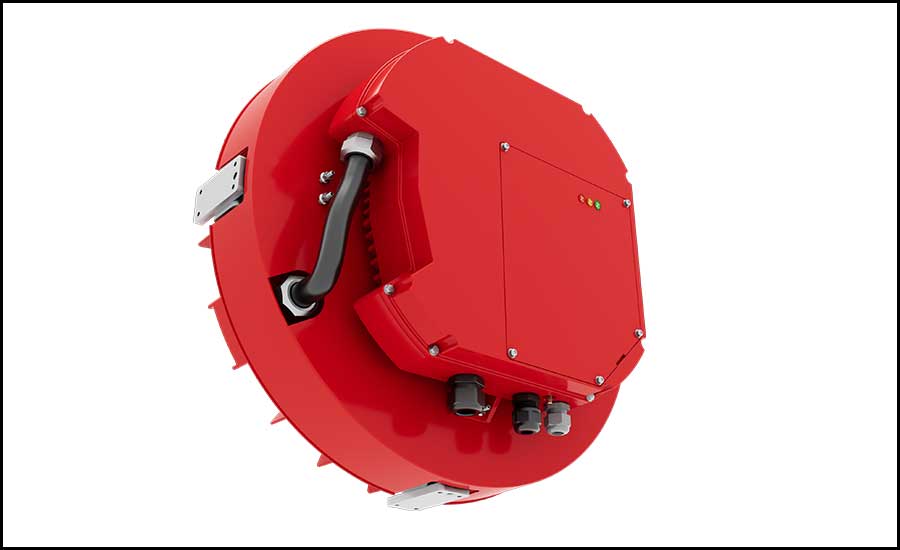Engineered Systems Magazine is proud to announce its 2024 Product Excellence Award recipients.
Daikin won the cooling equipment category with its energy efficient magnetic bearing centrifugal chiller, Magnitude WMT. Lochinvar won the heating equipment category with its air source heat pump water heater (HPWH), Veritus.
Ruskin won the IAQ and ventilation category with its TDFi-FA thermal dispersion fan inlet device for fan array applications. Uponor won the miscellaneous category with its AquaPort, a self-contained unit that converts a building's hydronic heating supply to provide on-demand domestic hot water. Infinitum won the motors and drives category with its Aircore EC motor system.
Read on to learn more about why each of these products won out of over 20 submissions:





Images courtesy of Daikin, Lochinvar, Ruskin, Uponor, and Infinitum
Cooling Equipment: Daikin Magnitude WMT
Daikin’s Magnitude WMT is a magnetic bearing centrifugal chiller designed to deliver market-leading energy efficiency while minimizing environmental impact. The Magnitude WMT boasts an industry-leading full-load efficiency of 0.48 kilowatts per ton and part-load efficiency of 0.30 kilowatts per ton, outperforming standard centrifugal chillers by up to 40%.
A key factor in the chiller's efficiency is its use of R-1233zd(E), a next-generation refrigerant with an ultra-low global warming potential (GWP) of just 1. This eco-friendly choice reflects the growing trend towards HVAC solutions that reduce environmental impact.
The Magnitude WMT's compact footprint makes it an ideal choice for applications where space is limited. Its smaller size compared to similar chillers provides greater flexibility in system design and installation.
The chiller also features Daikin's RapidRestore and RideThrough technologies, which enable rapid recovery from power outages. This minimizes disruptions and supports mission-critical operations.
For building owners and facility managers, the Magnitude WMT offers long-term value through its oil-free magnetic bearing technology, which reduces mechanical wear and tear, promoting reliability and extending equipment life. Its low GWP refrigerant supports LEED certification goals.
Heating Equipment: Veritus Air Source Heat Pump Water Heater
Lochinvar’s Veritus is an air source heat pump water heater (HPWH) designed to maximize energy efficiency and simplify installation and operation. The Veritus HPWH boasts a high coefficient of performance (COP) and uses the low Global Warming Potential (GWP) refrigerant R-513A, supporting facility managers in meeting sustainability goals and adhering to environmental regulations.
A key feature of the Veritus HPWH is its user-friendly Smart Touch control panel, which simplifies setting adjustments and performance monitoring. The unit also incorporates a variable-speed Electronically Commutated Motor (ECM) circulator, which works in tandem with the flow control valve to provide tighter unit control, reduce noise levels, and enhance efficiency.
The Veritus HPWH is a versatile solution for a variety of commercial applications, particularly those with high hot water demands such as healthcare facilities, fitness centers, and dormitories. Up to 64 units can be banked together to match capacity to larger commercial water demands, and the modular design allows for flexible installation options.
Lochinvar developed the Veritus HPWH over two years, relying heavily on voice-of-customer surveys, industry collaborations, and learnings from previous heat pump water heater iterations. The unit's feature set reflects Lochinvar's extensive knowledge of commercial water heater and storage tank best practices, along with improvements from advanced engineering tools.
The Veritus HPWH is designed to reduce energy consumption as a heat pump water heater. It is one of the first heat pump water heaters to incorporate an ECM variable-speed circulator, which boosts efficiency and decreases energy consumption. By utilizing the low GWP refrigerant R-513A, Lochinvar reduces its environmental impact and ensures the unit will meet new and upcoming GWP code changes.
IAQ and Ventilation: Ruskin TDFi-FA
The Ruskin TDFi-FA is a thermal dispersion fan inlet device for fan array applications within commercial HVAC systems. The TDFi-FA uses highly accurate thermal dispersion sensing technology to measure airflow rate and temperature, communicating data to the building automation system (BAS) through analog outputs or communication protocols.
The TDFi-FA features a compact, cantilevered sensor design that mounts at the fan inlet and can serve as a single interface for up to 32 sensors across 16 fans of the same diameter. Standard cabling and a tool-free, one-touch setup simplifies installation and minimizes onsite labor costs. A built-in 1-, 2- or 3-point field calibration process uses actual airflow data, which can be communicated to the BAS through BACnet MS/TP or Modbus RTU network connectivity or through convenient analog outputs.
The TDFi-FA is engineered for fan array applications within commercial HVAC systems, such as air handling units (AHUs) and rooftop units (RTUs). Using thermal dispersion technology, the TDFi-FA measures site installation temperature and airflow data. The device data is used by the BAS to control fan speeds and adjust damper positions to maintain HVAC airflow requirements.
Ruskin developed the TDFi-FA over 1.5 years, building on the 2021 launch of the Ruskin TDFi-RT (multi-fan variation model) and using a combination of field trials and focus studies informed by voice of customer feedback. In-field installation and calibration activities provided real-world application insight guiding feature development, while market feedback helped influence price point.
The TDFi-FA features highly accurate thermal dispersion sensor technology of ±3% for velocities from 0 – 10,000FPM. Built-in 1-, 2- or 3-point field calibration uses actual airflows to achieve specified accuracy. One TDFi-FA host can collect up to 32 airflow and temperature values from a fan array installation using 16 fans of the same diameter, with each gathering information from up to 4 sensors.
The TDFi-FA unlocks critical airflow data and transmits it to the BAS, making it possible to automate control fan speeds and adjust damper positions to enhance ventilation efficiency based on building and ambient conditions, all while delivering optimal ventilation rates to the occupied space. The TDFi-FA has been independently tested and is listed under UL-60730-1, UL-60730-9 and UL-60730-2-15. The TDFi-FA is also leading the industry with compliance to UL-60335-1 and UL-60335-2-40 A2L flammable refrigerant standards.
Miscellaneous: Uponor AquaPort
Uponor’s AquaPort is a self-contained unit that converts a building's hydronic heating supply to provide on-demand domestic hot water. The AquaPort features a proportional control valve and double-wall heat exchanger to create the domestic hot water from the hydronic heating supply, eliminating the need for centralized domestic hot water and recirculation piping.
The AquaPort is ideal for multifamily, hospitality, assisted-living centers, and healthcare patient towers. Compared to traditional pipe-routing methods, incorporating AquaPorts can reduce hot-water energy use by up to 35%, eliminate up to 40% of unnecessary piping, mitigate microbial growth in the DHW system, and remove more than 50% of the total DHW volume in a building for greater sustainability and hygiene.
The AquaPort requires a closed-loop hydronic heating source to generate the domestic hot water, such as an on-site plant or connection to a district system. To maximize energy efficiencies, high-density buildings with low-flowing fixtures are ideal. The AquaPort has four FNPT threads at the bottom of the unit and needs a 6" deep wall with 14.5" between the studs and at least 24" of available height.
Uponor developed the AquaPort over several years, leveraging technology from their European partners who have been using heat-interface units (HIUs) for two decades. Research methods included using the test facility in Celle for performance analysis along with U.S. and Canada code requirements, European code requirements, key insights from the instantaneous water heater industry, and general construction methods in the U.S.
Motor: Infinitum Aircore EC
Infinitum’s latest generation of its Aircore EC motor system is designed to power HVAC equipment sustainably with less energy, less noise and waste. The Aircore EC features a lightweight printed circuit board stator, reusable materials, and a modular design, delivering class-leading efficiency, power, and torque density in a package that is 20% lighter than the previous version.
The Aircore EC motor system includes the industry's only silicon carbide-based integrated variable frequency drive, giving engineers the ability to design machines with precise power control to optimize energy consumption and deliver the exact amount of power needed at any given time. The motor replaces the heavy, copper wound iron stator found in traditional motors with a lightweight, printed circuit board (PCB) stator that is 10x more reliable. Compared to conventional motors, it is 10% more efficient, 50% smaller and lighter, uses 66% less copper, and produces 3dB lower sound power noise. The motor's modular design allows for housing, rotors, and stators to be reused multiple times to keep motors in service and out of landfills.
Infinitum's Aircore EC motors are used in a variety of fans, pumps, and compressors to sustainably cool some of the largest facilities in the world. Partners including Punker, Lau, Canarm, as well as OEMs and data center customers use Infinitum motors in their equipment. One customer, Canarm, uses Infinitum motors in their APL-DP-EC Series of plenum fans for air handling units, which are recognized for their space and energy savings and commonly used to cool data centers.
The Aircore EC motor meets all applicable codes and standards. With the introduction of electronics at the heart of the motor, Infinitum reduced the number of mechanical components, making the motor simpler to service and more reliable. Modular design allows end users to service themselves, replacing or repairing only the parts that do break.
The energy cost savings alone will pay for an Infinitum motor within the first year of operation. A single 10hp Infinitum motor system will save $30,000 in energy costs over 20 years, compared to a traditional AC induction motor + VFD. Data centers and large facilities can have hundreds or thousands of motors.
Austin Keating is an Illinois trade journalist specializing in fabrication, ventilation, conservation, and mechanical contracting, having previously covered agriculture and remote sensing as a correspondent for Planet Forward (2017-18), field editor for Informa magazine Prairie Farmer (2018-21), then editor of BNP Media's Point of Beginning (2021 until it was discontinued in 2022). He currently serves at BNP as editor of SNIPS NEWS, the 80-year-old sheet metal industry special section of biweekly newspaper ACHR NEWS, and edits for Engineered Systems, Today's Boiler, and Mission Critical magazines. He assists the company's RemTEC and Emerging Contaminants trade show as well.




.jpg?height=200&t=1701967653&width=200)
